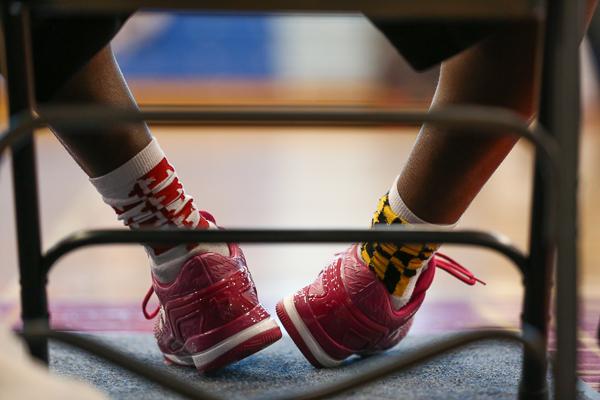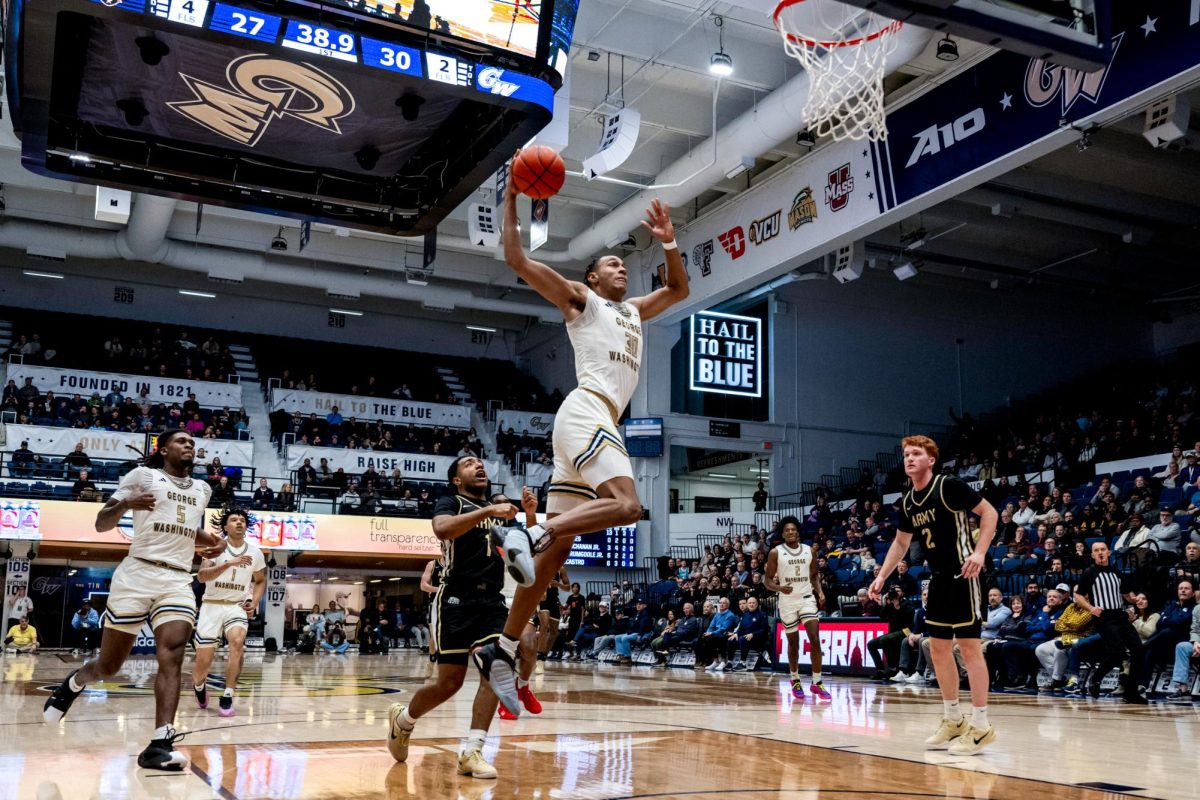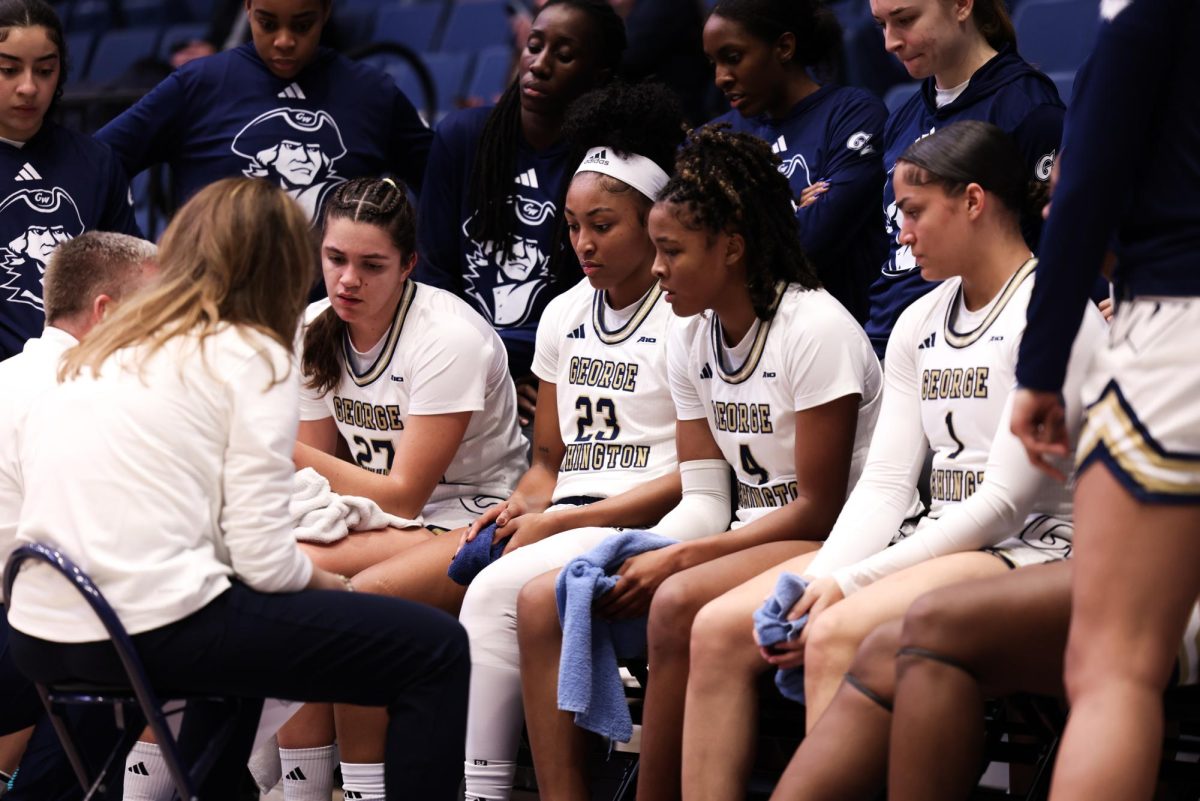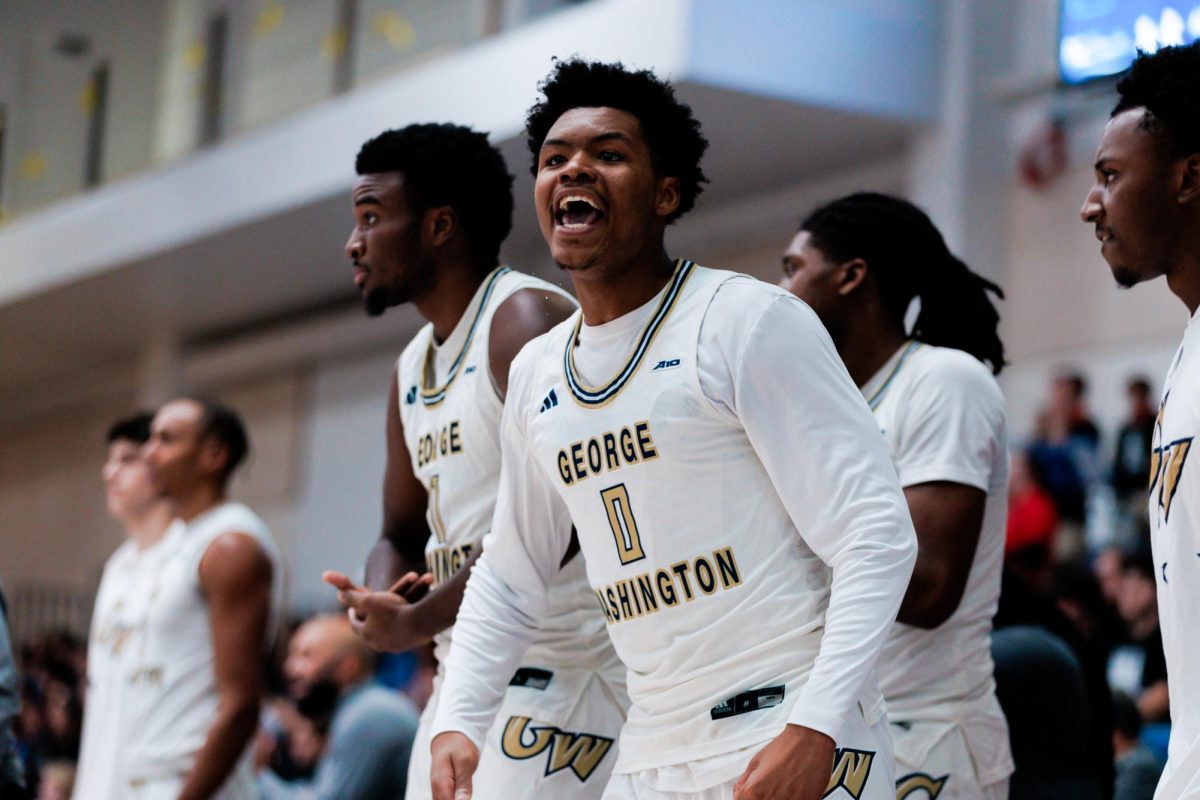Updated: April 6, 2015 at 1:39 p.m.
The Washington Post’s “D.C. Sports Bog” writer Scott Allen had one assignment for the Jan. 22 Wizards’ game against the Oklahoma City Thunder: talk to Kevin Durant fans.
The game was an overtime thriller, featuring a posterizing dunk and a contested three-pointer by the Suitland, Md. native. The highlight for Allen was a makeshift Durant jersey that had the player’s name in duct tape – one of the many signs of the “KD2DC” movement.
If Durant ever played for the Wizards, Nike billboards likely wouldn’t welcome him home like LeBron James in Cleveland, but District residents would.
“I’m not a Wizards fan, but I’m a Durant fan,” said Darian Bryant, a Bowie, Md. product and GW rookie. Another local player, sophomore Nick Griffin, added, “Oh, this whole area would go crazy, man.”
If Durant were to return, he would see that in the last decade, the college basketball scene has significantly grown in the DMV. In 2006, DMV teams averaged 3.45 local players on their rosters. In 2015, they averaged 3.63, an about 5 percent increase.
The big three – Georgetown, Maryland and Virginia – all went dancing this year as high seeds with high hopes. Across the board, colleges in the region, like GW, have had successful seasons in part because they have found a way to keep their talent local: A rise in DMV pride has coincided with an increase in Amateur Athletic Union teams, and showcases hosted in the area have helped coaches connect to younger student athletes and keep them in the region.
“The local schools are doing a good job of recruiting out here and selling them on the stay at home and get better,” said Brenden Straughn, an assistant coach of popular DMV AAU club Team Takeover.
Stars seek greener pastures
Durant committed to play college basketball at the University of Texas on June 16, 2005, according to Yahoo! Sports, just before a day of mourning for D.C. It was nearly 19 years to the day that the legendary Len Bias had died of a cocaine overdose.
The Maryland basketball all-time great and Landover, Md. native brought life and pride to the city’s basketball scene. He died June 19, 1986.

“After that, you probably had a lot of people who wanted to be the next Bias,” Allen said.
After Bias’ death, the D.C. area earned more national recognition as one of the country’s top pools of talent, serving as home to the most NBA basketball players per capita. But very few of those talents stayed in the area after high school.
The first overall pick in the 1987 draft was future Hall of Famer David Robinson, a Florida native who went to high school in Manassas, Va. Two DMV products joined Robinson in the first round of the ‘87 draft: Muggsy Bogues and Reggie Lewis. Neither of the two had stayed in the area for college.
In the next four years, five players who were selected in the first round of their respective NBA Drafts came from the area, but rarely had the DMV-raised crop stayed home to play college ball. Jerrod Mustaf, who went to Maryland, was the lone exception among that group of first-rounders. The second overall pick in 1989, Hyattsville, Md. native Danny Ferry, went to Duke.
Durant in many ways followed in the footsteps of Bias: Both were second overall picks in the NBA Draft and harbingers of surges in DMV basketball pride. But Durant was still convinced to leave. Though Bias was the inspiration for many area players, the Terp was the exception, not the rule.
The culture shift came in the years just after Durant chose to leave.
It was the District’s time to dance: In that 2006 tournament, Mason made it to the Final Four with seven players from the greater DMV area, all of whom averaged more than 10 points per game. The Cinderella story of a group of kids from the Capital region chilled brackets and warmed hearts on a national stage.
Meanwhile, the Colonials qualified as an No. 8 seed in the tournament, winning their first-round game. As a No. 7 seed, Georgetown fell to eventual champs Florida in the Sweet 16.
In 2007, more pieces came together for the DMV.
Durant’s Texas lost in the second round to lower-seeded USC. Maryland was a No. 4 seed, losing in the second round to Butler, but not before defeating a Davidson team with a freshman sharpshooter named Stephen Curry.
That Terrapins team had seven DMV products, including star Greivis Vasquez, who spent some of his high school career playing with Durant at powerhouse Montrose Christian after moving to Rockville, Md. from Venezuela. The next year, the Terps would boast nine players from the DMV, a school-high for the past decade.
“He prided himself in finding the diamond in the rough, which just speaks to just how much talent there is,” the Post’s Allen said about former Maryland head coach Gary Williams, who won a national title in 2002.
Williams was criticized later in his coaching career for passing up AAU-bred talent. Baltimore-born AAU Rudy Gay slipped past Williams, going on to lead Connecticut to the Elite Eight in 2006 and eventually become an NBA All-Star.
The Hoyas made their Final Four journey in 2007 with three athletes from the DMV: Roy Hibbert, Jeff Green and DaJuan Summer. All three would go on to play in the NBA.
The two successful years for the region were more of a lucky circumstance, signaling to others that they should recruit like that, too. The success of players staying in the D.C. area coupled with Durant’s budding superstardom got the DMV noticed as a true recruiting hotbed. Local coaches doubled down their efforts to use staying home as a recruiting point and stack their rosters with homegrown talent.
As the recruiting model began to change, with the introduction of more local-oriented showcases, the DMV institutionalized the system that happened to work in the mid-2000’s through programs like Straughn’s AAU teams.
“I’m in that same kind of Durant age frame. A lot of the guys were leaving home, going to Carolinas, the Texases, the Kansas States,” assistant coach Straughn said. “But now with the Melo Trimbles and Dion Wileys, and guys at GW, the local schools, even Georgetown to an extent, guys are trying to stay home. It’s good for the area.”
Supporting, showcasing talent
Tree limbs swayed in the wind above empty courts and, in the suburbs, the snow was still solid on the sides of the streets by Holy Trinity elementary in Glenn Dale, Md. – about a 10-minute drive from the New Carrollton Metro stop.
Cars packed a parking lot by the school on a Saturday afternoon in February. Juxtaposed with the quiet suburb was a giant, white sports bubble, a pop-up structure used to host athletic events. Inside, student athletes in the sixth, seventh and eighth grades assembled for their respective DMVelite basketball winter league games. This wasn’t a local rec league: These kids orchestrated every play, and they could dunk.
DMVelite was founded in 2008 and started producing talent for coaches on a regular basis in 2010. Chris Lawson, a longtime resident of D.C. and former coach of Bowie High School and various AAU teams, is the agency’s chief executive officer and founder.
“I just thought for so much talent here in our area, we could do more, locally, to support that effort compared to loading up the minivans and dredging across the region and getting on planes and all of that,” Lawson said.
More showcases are popping up to thicken the local web that connects college coaching staffs to talent, like the second annual Metro Challenge 60 at DeMatha Catholic High School, which took place in March. While area schools in the mid-2000s realized that local players were bringing success, showcases exist now because they serve as a place for coaches to actively seek out the players.

“Even some of the smaller schools are still doing well,” said GW junior and Lorton, Va. native Joe McDonald. “I think they’re realizing that keeping the talent here, because there’s a lot in this Northeastern area, especially in the DMV area, so I think they are starting to recruit a little bit closer.”
A group of four scouts from services like ESPN and Rivals at the Metro Challenge 60 said that 50 of the 60 players were expected to go Division I. A couple were already committed: Anthony Cowan to Maryland and Corey Manigault to Pittsburgh (despite receiving offers from Georgetown, Maryland and VCU, among others).
Experts attribute Maryland’s success in the past couple years to landing big-time local recruits under head coach Mark Turgeon. Two key players on the team are Melo Trimble and Dion Wiley, both local players, who Turgeon said were a “priority to recruit.”
Turgeon said they have gained a following among local kids, and that their success could be a building block for landing more D.C. area talent.
“As all these local programs continue to experience success both as a team and individually, it can be beneficial for each of our programs residing in the DMV,” Turgeon said in an email.
For some like George Mason, which has experienced a well-documented fall from the team’s glory days in the mid-2000s, recruiting has faced major criticism. The Patriots fired their most recent head coach Paul Hewitt after another losing season and a loss in the first round of this year’s Atlantic 10 Championship in Brooklyn, N.Y.
He spoke to the media after a loss to Fordham, saying he knew that he was in the hot seat.
“We’ve done a pretty decent job recruiting, but of course we’re going to look for where they have good players,” Hewitt said. “If that means coming back to New York, we’ll do that.”
This year, Mason had five local players on their roster, including one of their leaders, Patrick Holloway. The rest of the group was unable to produce. Most of the key contributors on the banged-up team were New York natives – a hard pill for fans to swallow after they were told that their backyards breed was the best in the nation.
And of course, the strength of local college programs impacts their ability to recruit and foster local talent. GW men’s basketball junior Kethan Savage, a Fairfax County, Va. native and former Team Takeover player, said that one supports the other.
“I’ve been in college three years now. I think now the college teams in this area have really picked up,” Savage said. “Georgetown has always been strong. But American [and] GW went to the tournament last year. Teams are getting better, talent is getting better, so I think it’s encouraging local talents to stay here.”
The men’s basketball team announced last week that Savage is looking to transfer from the program. Bryant and Griffin have also announced their intentions to transfer.
The fight for District supremacy
It’s tough to deny the potential of the DMV during a year when Georgetown, Maryland, Virginia, and VCU all went to the Big Dance, while GW and Old Dominion went to the NIT and American was one Patriot League win short of qualifying for the NCAA Tournament again.
But that talent is a double-edged sword. The recruiting scene is turning into a feeding frenzy among local teams as recruiting services direct all eyes toward the skilled players of the DMV, the gritty players of Baltimore City and the do-it-all sharpshooters of Northern Virginia.
“It’s just hard in this area to find a kid who no one knows about it. You can still go to other states and find those kids,” GW head coach Mike Lonergan said. “This area is so over-recruited.”
Top-tier programs in the area like Georgetown, Maryland and Virginia scoop up many of the best players. In the past decade, the Cavaliers have averaged just over two DMV players per season. This year, Virginia was led by Montrose Christian product Justin Anderson.
With the top talent claimed, it leaves programs like GW and VCU to try to grab the next best. Many mid-majors are doing well, but are being forced to reevaluate their strategies.

American has maintained a couple local players on its roster, rarely fluctuating, while James Madison has not had a DMV player since 2011. Towson’s number of local players has dipped to as few as two in 2013. UMBC has found a way to quickly fill up its roster with regional players, from one in 2011 to eight this past year.
“We already lost a kid to Virginia this year, lost a kid to Maryland,” Lonergan said. “It’s hard. It’s still hard to win those recruiting battles, but at least we’re in the conversation now. We just need to get some of those kids to believe in what we’re doing here.”
But a flourishing basketball culture can ultimately be one of the biggest tools for a coach.
Under Armour personally designs all of the gear for Maryland. The Terps football team adopted uniforms with the state flag printed on them in 2011, which sent social media abuzz and caught on with local kids. Head to a DMV youth basketball game, and teenagers will be sporting Maryland flag basketball socks.
They also wear Durant gear – and many of the athlete’s personal Nike line. GW is a Nike school, but Lonergan has even higher hopes for further branding the local culture.
“Georgetown is Jordan brand and Maryland is Under Armour,” Longergan said. “I’d like to become a Kevin Durant school.”







